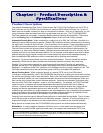
Multi-Tech Systems, Inc. FaxFinder Admin User Guide 4
Chapter 1 – Product Description &
Specifications
Product Description
This manual describes four Multi-Tech V.34 fax servers: the FF120 1-Port FaxFinder unit, the FF220 2-
Port FaxFinder unit, the FF420 4-Port FaxFinder unit, and the FF820 8-Port FaxFinder unit. All four of
these units are complete, economical, easy-to-use network fax servers. With any of these units, you can
receive faxes as emails and send faxes from any application that can print. The FF120/220/420/820
FaxFinder operates in two modes: Automated Routing Mode and Manual Routing Mode.
1
The mode is
set in the Routing field of the Modem Configuration screen of the FaxFinder Server software.
Automated Routing Mode. When connected to a station port on a PBX, the FaxFinder functions as a
network fax server with two-way fax service. Multiple PBX extension numbers are dedicated to incoming
fax traffic which is routed to the FaxFinder. (Only one station port is needed. Faxes transmitted to any of
the PBX’s fax-dedicated extension numbers all go to the station port serving the FF120/220/420/820.)
The FaxFinder converts the incoming faxes into graphic files that are sent as email attachments to fax
recipients on or beyond the Ethernet network. (Because faxes are delivered in the form of email, the fax
recipient could be at any reach-able email address. So, for example, a sales person could receive faxes
while traveling by using a regular company fax number and picking up the email messages remotely.)
Each fax-dedicated PBX extension number is associated with a particular email address.
Receiving. Fax clients receive faxes in the form of email attachments. From the remote fax sender’s
perspective, PBX extension phone numbers are functionally identical to ordinary fax phone lines.
Sending. Fax clients on the network can send faxes directly from their PCs using any application
program that can print. The application program must be set so that the FaxFinder itself is its printing
destination. In response to the ‘Print’ command, the FaxFinder turns the ‘print file’ image into a fax. The
FaxFinder transmits the fax to the public phone system (PSTN) or to another PBX extension.
Manual Routing Mode. When connected directly to a regular POTS line (or to a PBX without
‘convergent’ routing capability), the FF120/220/420/820 functions as an outgoing fax server with incoming
fax service going through one or more attendants. Each of the FaxFinder’s modems has a separate fax
number and each modem can have a separate attendant that receives the fax messages as emails and
then has the duty to direct them to their intended recipients. (Note that one attendant could serve more
than one of the FaxFinder’s modems – some or all of the modems.) For example, an FF820 FaxFinder
might be used in a company with several departments that regularly receive faxes but in differing
volumes. Suppose the sales department and the purchasing department receive many faxes and the
shipping and service departments receive much less fax traffic. In that case, three of the FF820’s
modems might direct faxes to a single attendant in the sales department, and an additional three modems
might direct faxes to the purchasing department; one modem might be directed to an attendant for the
shipping department and another to an attendant for the service department.
Outgoing faxes work the same in Manual Routing Mode as in Automated Routing Mode. That is, to send
a fax, the user prints to the FaxFinder from an application program. However, all incoming faxes go to a
single email recipient, the attendant, who then sends them on, as needed, to the intended recipient.
Being devices of multiple ports, the FF220/420/820 units can send and receive faxes simultaneously.
Mixed Mode. It is also possible to operate a FaxFinder unit in a mixed mode such that some of its
modems are connected to PBX extensions while other of its modems are connected to POTS lines.
1
For FF120/220/420/820 compatibility in Automated Routing Mode, the PBX must support ‘convergent routing,’
that is, the routing of multiple extension numbers to a single station port. PBXs lacking this functionality can still
be used with the FaxFinder in Manual Routing Mode.


















